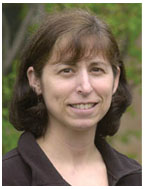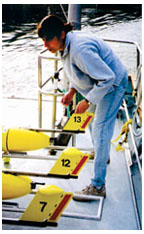December 17, 2003: Notebook
Justice O’Connor visits campus
George Frost Kennan ’25 honored Secretary of State Colin Powell to speak at conference
The daily grind: Where Princetonians go for their brew
Breaking
ground: mechanical engineering
Exploring the unknown, underwater

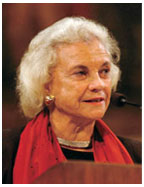 |
| Photo by Denise Applewhite |
Supreme Court Justice Sandra Day O’Connor spoke at Princeton in honor of Justice John Marshall Harlan ’20.In a visit to campus November 17, U.S. Supreme Court Justice Sandra Day O’Connor paid tribute to John Marshall Harlan ’20 and his approach to Constitutional law, suggesting that justices should “follow Justice Harlan’s example of respect for the values that undergird that great document,” the Constitution.
O’Connor, a 22-year veteran of the court, delivered the first John Marshall Harlan ’20 Lecture in Constitutional Jurisprudence, honoring the conservative justice known mostly for his dissents, including his defense of the right to privacy in the 1961 case Poe v. Ullman, which set a precedent for subsequent privacy cases.
O’Connor focused on Harlan’s respect for tradition, judicial precedent, the separation of powers, and state sovereignty. While he left the court a decade before O’Connor’s appointment, she said that Harlan’s work, particularly his well-crafted writing, is widely respected by the current justices.
The grandson of a Supreme Court justice with the same name, Harlan was the president of his class and chairman of the Daily Princetonian as an undergraduate. After a career in private practice and public service, he was appointed to the high court by President Eisenhower in 1955. He retired shortly before his death in 1971.
In the lecture, O’Connor did not share her thoughts on current
issues. In 2002, O’Connor wrote the Court’s opinion in Grutter
v. Bollinger, allowing racial preference as a factor in admissions at
the University of Michigan Law School. She wrote, “We expect that
25 years from now, the use of racial preferences will no longer be necessary
to further the interest approved today.” At O’Connor’s
talk, President Tilghman said that universities have an obligation to
“get busy” in realizing that goal. ![]()
By B.T.

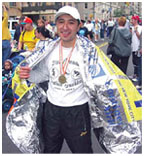 |
|
|
James Mejia GS finishes the New York City Marathon last month as part
of an experiment born in engineering professor Alain Kornhauser’s
seminar, Domestic Policy Analysis in Transportation. Mejia, a master’s
student at the Woodrow Wilson School, wore a fanny pack that held Kornhauser’s
new global-positioning-system tracking equipment, which continuously transmitted
his location to a remote computer. People around the world were able to
track Mejia’s progress over the course of the 26.2 miles and could
send him questions, to which Mejia could answer “yes” or “no”
by pressing a button on the system.
![]()

The honor code. Global inequality. Chocolate cake. This fall, Princeton students have taken on ethical dilemmas, large and small, with well-known speakers, at an ongoing series called Do the Right Thing.
Randy Cohen, who writes “The Ethicist” column for the New York Times Magazine, came to Princeton in October to speak about his work and decision-making process. Afterward, students asked him about downloading music, the honor code, and the ethics of a nutritionally conscious girl who abstains from chocolate cake but encourages her friends to eat it as a form of sabotage.
“I don’t think that nutritional information is specialized knowledge. I mean, the whole chocolate cake thing has gotten out,” Cohen said.
At Princeton professor of bioethics Peter Singer’s talk in November, the crowd spilled into the stairwell, leading him to liken the setup to global inequality, with rich nations enjoying more than their share of resources at the expense of the luckless majority. During the question-and-answer session, one student asked, “Attending a university like Princeton is a luxury. Can we justify it?”
“If you take the University’s mission seriously — Princeton
in the nation’s service and in the service of all nations —
and use your education accordingly, it is justified.” Singer said.
![]()
By Kate Swearengen ’04

 |
| (Photo: Office of Communications) |
Karl D. Uitti , the John N. Woodhull Professor of Modern Languages and a professor of French and Italian, died November 11. He was 69.
A former chairman of the Department of Romance Languages and Literatures, Uitti was a member of the faculty for 44 years and specialized in French medieval literature. He wrote several books and monographs as well as dozens of articles and reviews. The main focus of his research was in medieval Romance studies, but his published work covered a range of subjects, including late 19th- and early 20th-century French literature, modern literature, history and theory of literary criticism and analysis, and theory and history of philology.
Most recently, Uitti was leading the Charette Project, which involves computerization of the medieval Lancelot manuscript tradition.
 |
|
Jerome W. Clinton |
Jerome W. Clinton, professor emeritus of Near Eastern studies, died November 7 of cancer. He was 66.
A graduate of Stanford University, Clinton received his M.A. in English and American literature at the University of Pennsylvania, and spent two years in the Peace Corps in Iran. After earning his Ph.D. in 1972 from the University of Michigan in Persian and Arabic literature, he returned to Iran as director of the Tehran Center of the American Institute of Iranian Studies. In 1974 he was appointed professor of Persian at Princeton, where he taught for 28 years. He retired last year.
Clinton’s main interests were literary criticism, language teaching,
and translation. He was the author of numerous articles, and a noted scholar
and translator of the Persian epic the Shahnameh (Book of Kings). One
of his most recent projects at Princeton was developing an online archive
of illustrations from the Shahnameh. ![]()

President Tilghman’s salary in 2001—02 ranked 30th among U.S. college presidents and sixth in the Ivy League, according to I.R.S. data compiled and published by the Chronicle of Higher Education. Tilghman’s pay and benefits totaled $486,667. Judith Rodin of the University of Pennsylvania had the highest compensation of the Ivy presidents, $845,474.
The report found that from 1997 to 2001, presidential salaries at private and public universities increased consistently. The $385,631 median salary for presidents at doctoral/research universities in 2000—01, the last year full data were available, showed an inflation-adjusted increase of 6.3 percent from the previous year.
As a nonprofit organization, the University is required to file I.R.S.
Form 990, which lists the salaries and benefits of its officers and its
five highest-paid employees. Andrew Golden, president of the Princeton
University Investment Company (Princo), earned total compensation of $770,682,
making him the University’s highest-paid employee. Former president
Harold Shapiro *64 is listed among the top five in 2001-02, earning $542,249
as a professor of public and international affairs and president emeritus.
![]()
By B.T.

 |
|
Photo: William Russel (Frank Wojciechowski) |
Since becoming dean of the Graduate School in August 2002, William Russel has been reaching out to Princeton’s 19,000 graduate alumni. Building on a plan outlined by his predecessor, John Wilson, he has been working to build stronger relationships with graduate alumni and to bring more graduate alumni into the Princeton fold.
Russel traveled this fall to Chicago and Denver to meet with graduate alumni at regional events; this spring he will visit San Francisco and New York. Another effort is a new Graduate School Web site, which will be launched in January to provide more complete and timely information.
Since graduate students tend to have stronger ties with their home departments than they do with the University as a whole, Russel has been encouraging academic departments to keep in contact with their graduate alumni through newsletters, e-mail, and reunions. “Following our graduate alumni in their careers provides an important measure of how well we are doing our jobs,” said Russel, a longtime professor of chemical engineering. “It also gives us the opportunity to attract their support.”
At the top of Russel’s agenda is increasing the participation of graduate alumni on the Alumni Council and the Board of Trustees, along with better integrating the Association of Princeton Graduate Alumni into the University community.
Encouraging graduate contributions to Annual Giving is another major objective. Last year 13.8 percent of graduate alumni contributed, including undergraduate alumni who also hold degrees from the Graduate School. Undergraduate participation was 59 percent last year.
Any plan for departmental outreach, says Russel, must take into account
the changing nature of research as it becomes more cross-disciplinary.
“Cross-disciplinary research continues to translate into exciting
interdepartmental programs for graduate students. It’s likely that
program students, in addition to connections developed with participating
departments, would also have ties to the program itself, offering yet
another way to reach out to them.” ![]()
By Jordan Paul Amadio ’05

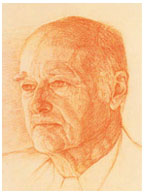 |
|
Illustration: mary A. bundy
Below: The first page of Kennan’s Long Telegram, on display at Firestone Library. (Photographed by Frank Wojciechowski) |
George Frost Kennan ’25 honored
Secretary of State Colin Powell to speak at conference
For a man who began a career in the Foreign Service almost by chance, and never rose much higher than a midlevel position, George Frost Kennan ’25 had a profound effect on U.S. foreign policy. Best known as the author of the “Containment” doctrine that became the foundation of U.S. policy toward the Soviet Union during the Cold War, Kennan said later that the policy was misunderstood and misapplied. He felt he had “loosened a large boulder from the top of a cliff,” Kennan wrote in his Memoirs (1967), and helplessly witnessed “its path of destruction in the valley below.”
As Kennan approaches his 100th birthday on February 16, 2004, Princeton is exploring the Cold War period and his role in it, in an exhibition at Firestone Library, “The Life and Times of George F. Kennan,” which runs through April 18. U.S. Secretary of State Colin L. Powell will give the keynote address at a conference celebrating Kennan’s life on February 20, 2004.
“While Kennan is not widely known by the general public, his contribution to U.S. history is legend within the diplomatic community,” says University archivist Daniel Linke, a co-organizer of the exhibition.
In his Memoirs, Kennan, who grew up in Wisconsin, says he decided to enter the Foreign Service because he had the “feeling that I did not know what else to do.” After passing the exams, he was sent to various posts in Europe, and in 1928 undertook special training in Russian affairs in Berlin.
He was 29 when he first went to Moscow in 1933; over the next 20 years, serving in various foreign-service positions there and in other cities, he would come to know the Soviets well.
In 1946, at age 42, Kennan sent what has come to be known as the “Long Telegram” to the State Department. In the 8,000-word, 18-page telegram, on display in Firestone’s main gallery, Kennan wrote that Joseph Stalin’s regime was a “political force committed fanatically to the belief that with the U.S. there can be no permanent modus vivendi, that it is desirable and necessary that the internal harmony of our society be disrupted, our traditional way of life be destroyed, the international authority of our state be broken.”
 He continued
his analysis, arguing that the Soviet challenge was “within our power
to solve – and without recourse to any general military conflict.”
The telegram ended with an exhortation: “. . . the greatest danger
that can befall us in coping with this problem of Soviet communism, is
that we shall allow ourselves to become like those with whom we are coping.”
He continued
his analysis, arguing that the Soviet challenge was “within our power
to solve – and without recourse to any general military conflict.”
The telegram ended with an exhortation: “. . . the greatest danger
that can befall us in coping with this problem of Soviet communism, is
that we shall allow ourselves to become like those with whom we are coping.”
In July 1947, with the Cold War a reality, Kennan wrote an anonymous article for Foreign Affairs magazine, “The Sources of Soviet Conduct,” by “X,” which was based on the Long Telegram and outlined a strategy for dealing with the Soviet Union. The word “containment” appeared in the article three times, and a political doctrine was born. While Kennan had argued for a nuanced policy of a “long-term, patient but firm and vigilant containment of Russian expansive tendencies,” his argument was interpreted in far blunter ways, which caused Kennan much regret. He later wrote that he had intended the article to be a plea that war was not inevitable, and that there was “a middle ground of political resistance on which we could stand with reasonable prospect of success.”
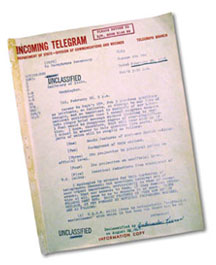 Princeton
history professor Stephen Kotkin, director of the University’s Russian
studies program, calls Kennan “a rare statesman-scholar. He understood
very early on, and ably explained to policymakers and the public, the
imperative to stand up to Communism. He also warned, in battling the Communists,
not to become like them, not to adopt their methods, not to compromise
our institutions and our freedoms in the necessary Cold War struggle.”
Princeton
history professor Stephen Kotkin, director of the University’s Russian
studies program, calls Kennan “a rare statesman-scholar. He understood
very early on, and ably explained to policymakers and the public, the
imperative to stand up to Communism. He also warned, in battling the Communists,
not to become like them, not to adopt their methods, not to compromise
our institutions and our freedoms in the necessary Cold War struggle.”
In addition to the Long Telegram and the Foreign Affairs article, the exhibit at Firestone includes poems Kennan wrote as a teenager, an early Princeton report card, and photographs, letters, diary entries, and memos prepared during Kennan’s time at Princeton and throughout his career. The material was drawn from 20 collections at the University, said Linke, including Kennan’s own papers and those of former Secretary of Defense James Forrestal ’15, and former Secretaries of State Robert Lansing and John Foster Dulles ’08. Kennan gave his papers to the University in 1968; while many are already available to researchers, some will be opened only after his death.
“As a diplomat, Kennan is most remembered for the Long Telegram,” says Jack F. Matlock, former U.S. ambassador to the U.S.S.R. and a lecturer at the Woodrow Wilson School, but “no less important was his contribution to the Marshall Plan, which he helped draft as head of the State Department’s policy-planning staff.” Matlock also cites Kennan’s written work, including his memoirs, as major contributions to understanding 20th-century diplomacy.
Matlock is a participant in the conference, which will bring together scholars, journalists, and diplomats who served during the Cold War or at its end, or are working in diplomacy today. Other expected speakers include Robert Tucker, professor emeritus of politics and a specialist in Soviet affairs; Joseph Nye ’58, dean of the Kennedy School of Government at Harvard; Kennan’s biographer, John Lewis Gaddis; and journalist Don Oberdorfer ’52. Like Matlock, Oberdorfer lauds Kennan as a critic and writer. “His extensive writings in memoirs, other books and articles, and periodic public testimony were seriously regarded for decades by both sides in foreign policy debates, especially those of the Cold War. An important part of the story was his great skill as a writer of the English language,” he says.
Kennan, who still lives in Princeton, continues to keep abreast of world
events. In a New Yorker magazine interview October 14, 2002, he told writer
Jane Mayer that he saw grave peril and little justification for the Bush
administration’s proposed preemptive strike on Iraq. And in a letter
to the editor of the Washington Post on March 25, 2003, Kennan wrote,
“I am extremely concerned about the shameful, almost total passivity
of Congress during the period of preparations for our military attack
on Iraq. Congress’s inaction is a dangerous precedent in executive-legislative
relations. In light of this precedent, future presidents will be tempted
to seize virtually dictatorial powers under the title of commander-in-chief,
and nothing in our history rules out the possibility of their yielding
to that temptation. This seems to be the meaning of the recent crisis.”
![]()
By L.O.

 |
| Photo: Daniel Kahneman (office of communications) |
Science of happiness — Do people know what will make them happy? At the annual Albert Einstein Memorial Lecture October 30, Professor of Psychology and Public Affairs and Nobel laureate Daniel Kahneman examined the emerging scientific study of well-being. Often, he said, we are not very good at predicting what will make us happy, though people tend to adapt and become content.
In one study, researchers secretly placed coins in a public phone for half the users, so their calls were free. Interviewed after exiting the phone booth, those who made free calls had significantly more positive responses to questions about their overall happiness than did those who had paid to use the phone.
While it may sound trivial, the phone-booth example provides insight into psychology and human behavior, with applications in both social and health sciences. Kahneman expects future well-being studies to capture immediate responses, as emotions tend to change after reflection.
 |
Irreducibly complex — When Lehigh University biochemistry professor Michael Behe outlined his skepticism about the far-reaching use of Darwinism in modern science, he provided a tongue-in-cheek disclaimer. “I should let you know that I do have some critics,” says Behe. “Not everyone agrees.”
Seven years after publishing his controversial book, Darwin’s Black Box, Behe’s ideas are still under fire. Speaking November 6, Behe argued that certain biochemical systems display an “irreducible complexity” that cannot be explained by a succession of Darwinian mutations. Instead, Behe credits “intelligent design” as the basis of elaborate natural mechanisms such as bacterial flagella and blood coagulation.
In a post-lecture session, students and faculty challenged Behe. He responded with examples of historical errors in Darwinism and of unexplained complex systems. Behe, a Catholic, admits that accepting intelligent design does not shed any light on the designer’s identity, which remains a matter of belief, not science.
 |
| (Photo: Ben Gurion university) |
Painful divorce — Amos Oz , one of Israel’s leading authors and a former Princeton visiting professor, returned to campus November 10 – this time, speaking not about literature, but about compromises needed for Mideast peace.
Oz was among the Israeli and Palestinian intellectuals, politicians, and activists who produced the new “Geneva Accord,” an unofficial blueprint for peace. While previous, failed peace plans took the path of “creative ambiguity,” this document addresses details including the status of Jerusalem, settlements, and refugees, Oz said. But he said that most citizens are “unhappily ready, through clenched teeth,” to make difficult compromise for a two-state solution. “I don’t expect a honeymoon – I expect a fair and just, but painful, divorce,” he said. “It will be very hard, but preferable to the living hell which the Israeli occupation is giving the Palestinians, and Palestinian terrorism is giving the Israelis.”
A literature professor at Ben Gurion University of the Negev, Oz said
he wished for a Chekhovian end to this Middle Eastern tragedy, rather
than a Shakespearian one. At the conclusion of a Shakespeare tragedy,
Oz said, the stage is littered with bodies, though justice has prevailed.
In Chekhov’s plays, “everyone is heartbroken, bitter, melancholy
– but alive.” ![]()
For Oz’s lecture, go to www.princeton.edu/ webmedia/lectures/.

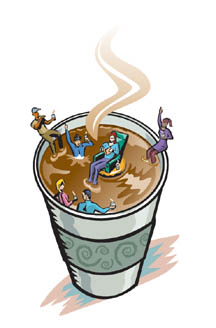 Until
recently, Princetonians didn’t have much choice when it came to getting
a cup of coffee. But now there’s a decent cup waiting every few feet,
on campus and off. PAW Managing Editor Lolly O’Brien and Lauren Turner
’04, a PAW student writer, visited the hot spots.
Until
recently, Princetonians didn’t have much choice when it came to getting
a cup of coffee. But now there’s a decent cup waiting every few feet,
on campus and off. PAW Managing Editor Lolly O’Brien and Lauren Turner
’04, a PAW student writer, visited the hot spots.
It is the most sought-after beverage at Princeton. It’s legal, it’s stimulating, it has few calories, and it’s readily available, on campus and off.
Coffee, latte, espresso, macchiato, decaf, cappuccino. . . . It’s all good. And it’s sipped, swilled, stirred, and savored by the gallon.
Measuring how much coffee is consumed on campus is not simple, but the numbers from a typical day at Café Vivian — named for the wife of former Princeton president Harold Shapiro – in the Frist Campus Center provide an idea. According to Matthew Smith, operations manager at Frist, the café serves 800 coffees each weekday. That’s 500 cups of American-style coffee, at $1.25 per cup, and 300 espresso-based coffees, together requiring 16 pounds of coffee. That means approximately 44 servings each hour the Café is open, from 7 a.m. to 2 a.m.
Overall, more than 12,000 pounds of coffee are brewed annually on campus, according to Dave Goetz of the Office of Dining Services. That yields more than a half million cups of coffee, served in a variety of locations, including Café Vivian.
Located on the middle floor of Frist Campus Center, Café Vivian – the most frequented coffee bar at the University – has some natural advantages: It’s on the way to classes and is an easy place to meet friends, hang out, and study to the beat of African drum music or U2. It’s also the only coffee shop that doesn’t require money. Students happily charge coffee and pastries to their mom-and-dad-pay-at-the-end-of-the-semester prox cards.
Other hangouts claim their regulars, too. Down Washington Road in the new Icahn Laboratory, chemical engineers, molecular biologists, and other scientists tank up with espressos and Sumatras from the Genomics Café, located in the middle of the soaring atrium designed by Rafael Viñoly. Lea Goentoro GS, a third-year chemical engineering student, buys at least two cups of coffee a day there, at $1.25 per cup: “The Sumatra is really good, and when you need a change of environment, from the lab, you can come down here. It’s more spacious, and it’s a place to meet fellow graduate students.” Greg Reeves GS, a second-year chemical engineering student, agrees. While Reeves doesn’t drink coffee, he does buy ice cream and says that the space encourages personal interaction. “It’s an interdisciplinary building,” he says.
The cheapest on-campus spot for coffee is at the Graduate College. At its coffee bar, 75-cent cups are dispensed from a thermos behind a counter arrayed with prepackaged snack crackers. But the bar is open only between 9 p.m. and midnight. On a recent night, the place was crowded with graduate students hunched over books, but most of them were not drinking coffee. Piper Harris GS, a first-year math student, was the only student with a coffee cup, and she had bought it at WaWa. “This is really less of a coffee place because they open at 9 and they don’t sell decaf,” she says.
Across the great divide of Nassau Street, coffee costs $1.45 at Bucks County Coffee in Palmer Square. Some Princetonians swear by the café’s drinks, local art, laptop-friendly electrical outlets, and chatty employees who don’t seem to mind if students camp out and work for hours during midterms. Bucks seems to attract its faithful during the vulnerable residential-college years when students are just developing their coffee addictions, and its most loyal customers tend to hail from Rockefeller and Mathey Colleges, both just across Nassau Street. Nobelist John Nash *50 often comes here. One Bucks counterman said Nash’s regular drink is a “grande decaf skim mocha,” but Nash, when asked to confirm his choice of beverage, elaborated, “It’s not really accurate; things like that are subject to constant changes. Not long ago I didn’t know about the possibility of the dietetic mocha made with skimmed milk. Tomorrow it will be something else.”
On Nassau Street itself, students have an array of coffee hangouts to choose from, including Panera, a brightly lit and colorful chain sandwich shop and bakery. Students say Panera offers far more than just free samples of asiago cheese bread and “You Choose Two” meal combinations; it boasts coffees, teas, and basic variations of the cappa-frappa-mochacino drinks. Signs like “Home is where the Hearty Grain is” don’t make Panera a popular date spot, but with its $1.29 bottomless cup of coffee, it has become a good study spot for in-the-know students. Those who can read amidst clanking plates and the smell of yeast bring headphones and work for hours on end.
At Starbucks, just up the street, students know exactly what the coffee will be like. If one thing can be said for the ubiquitous Starbucks, it’s that it makes a predictably reliable cup of coffee for $1.45, and what it lacks in character — mass-produced posters inspire with headlines such as “Dreaming of a Unique Place” and “Follow the Herd” — it makes up for in convenience and tables just big enough for one or two calculus books. Starbucks has its faithful. It “puts out a pretty solid espresso roast,” says Seattle native Kelly Lisbakken ’04. “It’s a consistent product.”
For serious caffeine stimulation, many swear by the independently owned Small World coffee shop, on Wither-spoon Street, with its Greenwich-Village-meets-grad-student-population atmosphere. Small World is the destination for students looking to discuss theses with professors, or undefined relationships with friends and lovers. The owners, young northern California refugees, serve a strong, dark, rich coffee they’ve roasted themselves, for $1.30 a cup. Local art, available for purchase, hangs on the walls, employees wear shirts that say “Fresh Music Served Daily,” and café au lait comes in two separate glass carafes for customers to mix in just the right proportions. At times, clots of students and faculty push tables together, creating informal coffee klatches.
President Tilghman stops in on her way to work for her usual double
cappuccino. Politics professor Robert George once a week gets his “double
decaf milky shot,” described as “two shots of decaf espresso
in a small cup, filled to the 3/4 point with steamed milk (no foam).”
Poet Paul Muldoon reports that he visits Small World daily. “I get
a double latte to go there pretty much every morning,” he says. “It
sets me up nicely for poetry-writing.” ![]()

|
Naomi Leonard ’85 (Photo: Frank Wojciechowski)
|
|
Professor Naomi Leonard ’85, prepares to launch her gliders in Monterey Bay; the gliders in dry-land simulations. (Photo: Sara peters) |
Exploring the unknown, underwater
In August, Naomi Leonard ’85, professor of mechanical and aerospace engineering, and her team of seven researchers and students pushed a fleet of curious vessels off the deck of a boat in California’s Monterey Bay.
The yellow torpedo-shaped “gliders,” each about five feet in length and equipped with small wings and tailfins, set out to explore the bay and help scientists explain one of the area’s most significant oceanographic events: the upwelling of a cold plume of water from beneath the surface that brings nutrients and plankton to feed fish and other marine wildlife in the summer months.
The gliders are a type of autonomous underwater vehicle (A.U.V.), and while they may look simple, they have sophisticated data-gathering capabilities. By going deep into the ocean for long periods and occasionally rising to the surface to transmit readings via satellite links, gliders can collect data outside the reach of manned vessels. “You just give them the signal and they disappear,” Leonard says. “You don’t see them for a couple of weeks, but all this data is coming back. It’s incredibly impressive.”
Even more impressive was the fact that the three gliders in Leonard’s fleet were working together, using algorithms supplied by her team. Each individual glider controlled its course based on data readings and an algorithm on an onboard computer. The gliders also adjusted their movements cooperatively, by sharing data when they surfaced, so that they could stay in a formation and collect relevant data. In formation, the fleet could estimate gradients of temperature, salinity, and even biological variables such as the presence of chlorophyll. The gradient estimates will be used to draw the fleet closer to the best data available in future experiments.
Leonard draws inspiration for her innovative model of “foraging” for data from the movements of a school of fish, a biological example of effective cooperation. If the gliders worked independently, they would each focus on the most important source of data, leaving the second and third most important areas uncovered. Coordination allows the gliders to find a better range of data, providing information that independent A.U.V.s would not collect. “It’s all about being in the right place at the right time,” Leonard says. “When that upwelling happens, you want to make sure that you’re there. And it’s about coverage – making sure you’re getting the important data.”
With 12 or more gliders in the water at once and more than a dozen universities and research institutions gathering and producing data — all part of a larger project called the Autonomous Ocean Sampling Network II (A.O.S.N. II) — the scope of A.U.V. use has expanded. In an October U.S. News and World Report story about the project, Francisco Chavez of the Monterey Bay Aquarium Research Institute called A.U.V. networks oceanography’s “equivalent of the Hubble Space Telescope,” an assessment Leonard supports. “Ships can move fast, but you’re very constrained, and they’re very expensive,” she says. With A.U.V.s, “you have less to worry about. You don’t want the gliders to crash, so there are safeguards. You don’t go certain places. But the opportunities are really huge.” In addition to observing ocean dynamics, A.U.V.s can be used to find sources of seismic activity underwater or to photograph marine life. They also may be used for search-and-rescue missions in the future.
Leonard, who majored in mechanical and aerospace engineering, received her master’s and doctorate in electrical engineering from the University of Maryland. After studying the control of robotics systems, including unmanned spacecraft, she began working with A.U.V.s because they provided both interesting theory and fascinating real-world applications. The next A.O.S.N. experiment is scheduled for 2005, and in the meantime, Leonard plans to work with gliders on the East Coast, collaborating with David Fratantoni of the Woods Hole Oceanographic Institution, which supplied the gliders for A.O.S.N. II.
“There’s something appealing about exploring unknown realms,”
says Leo-nard, who grew up near the ocean in Marblehead, Massachusetts.
“Space has always been so exciting because we know so little about
it and it’s so far away. But the sea is exciting and interesting
and very much unknown. It seems relatively close by, but it’s just
very difficult to get down there.” ![]()
By B.T.

 |
|
Princeton geophysicist W. Jason Morgan (Photo: Office of Communications) |
Princeton geophysicist W. Jason Morgan received the National Medal of Science, the nation’s highest scientific honor, for theories that describe how land masses move, volcanoes arise, and many other features of the land and sea take shape. The award was presented November 6 by President Bush. Morgan is the 15th member of Princeton’s faculty to receive the medal.
Bill Ford ’79 and Ford Motor Co. donated two new compressed natural-gas shuttle buses and a refueling station to the University, enabling an expansion of the campus shuttle bus system. In mid-November, the shuttle added an eastern loop that begins in the parking lot near Jadwin Gymnasium.
Princeton fans can take a journey back in time to see a century-old football contest through the eyes of Thomas Edison and his early motion-picture camera. Edison’s film of the 1903 Princeton-Yale game has been converted to online video by the Library of Congress.
The game, an 11—6 Princeton win, was recorded on November 19, 1903, almost 100 years to the day before this season’s November 15 Princeton-Yale game. A link to the video is available from the Library of Congress (http://memory.loc.gov/mbrs/awal/2164.mpg).
Applications to the University’s binding early decision program
declined by 23 percent for the Class of 2008, in response to what the
New York Times called a “changing landscape” of early admission
policies. According to the Times, Stanford and Yale saw significantly
more early applicants (up 62 percent and 42 percent, respectively) after
changing their policies, while Harvard’s early prospects dropped
by 47 percent following a move to stricter guidelines. Princeton’s
policy, which requires early applicants admitted in December to enroll,
has not changed. ![]()

